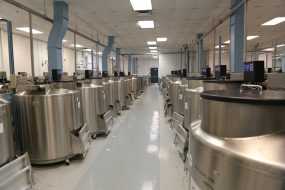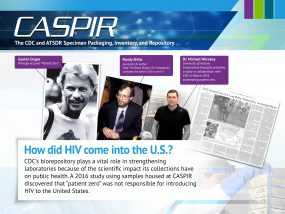CDC’s Biorepository and its Role in the Future of Public Health
Beyond Sample Preservation
Currently, the biorepository supports national surveys, such as the National Health and Nutrition Examination Survey, the Active Bacterial Core Surveillance Program, and the Child Health and Mortality Prevention Surveillance Network. “It is a thrill to work with important national and international surveillance programs that are relying on the services of CDC’s biorepository,” says Marcia Revelez, the Collections Manager at CASPIR. “We take great pleasure in providing quality services and data organization and hope our collaborations can further advance the health and safety of the public in the future.”

CASPIR facility where the majority of its 200 cryogenic vats are located.
The biorepository program remains focused on protecting the integrity of samples for future use. This determination led to a variety of storage options in CASPIR’s biosafety level two facility, including over 200 vapor-phase liquid nitrogen cryogenic vats, over 50 mechanical freezers, several refrigerators, and options for room temperature storage.
In addition to collection storage, CASPIR also provides many other services to contributors of the collections and the agency:
- Sample retrieval, transport, and shipping
- Cryoservices (supplying liquid nitrogen, dry ice, and gases)
- Creation of sample labels
- Sample handling and preparation
- Inventory management
- Records management
- Provision of CDC Unique Identifier and CDC Sample Identifier
Celebration of Expansion

APHL Infectious Diseases Laboratory fellows standing by during the ribbon cutting ceremony of the new expansion space.
In June 2017, CASPIR launched just over 3,000 square feet of new expansion space. The new space has a storage capacity, or an additional 28 cryogenic vats and 30 mechanical freezers, which can preserve an additional 2 million samples, ensuring that CASPIR can meet the needs of CDC for years to come.
To commemorate the event, an official ribbon cutting ceremony occurred with special visitors in attendance. These guests were some of the nation’s most promising public health workers – the Association of Public Health Laboratories Infectious Diseases Laboratory Fellows, who toured CASPIR’s facilities and witnessed the inauguration of the new space.
Moving Forward
In support of CASPIR’s vision and growth, a major revision of the CDC Biorepository Management Policy began this year. This policy will ensure the appropriate stewardship and management of collections admitted to CDC’s centralized biorepository. New standards are in place that align with broader best practices in biorepository science, including requirements for appropriate sharing of samples both within and outside of CDC. Furthermore, the revitalized CASPIR Advisory Committee meets monthly to offer guidance through discussions on ways CASPIR can support CDC programs and the broader scientific community.
Public Health Impact

“Biorepositories have evolved,” says Judith Giri, CASPIR’s Biorepository Consultant. “Instead of individual collections of samples for specific studies, biorepositories have become centralized, scientific resources essential for health research. CDC has been at the forefront of this evolution, starting with the establishment of CASPIR in 1997.”
For example, a 2016 CDC collaborative study using samples housed at CASPIR discovered that “patient zero” was not responsible for introducing HIV to the United States. Without these collections cataloged in CDC’s Biorepository, findings like this could not have occurred. If a discovery like this can help improve our understanding of what we think we know, imagine the possibilities of how these collections can contribute to improving our ability to better understand diseases and improve public health.
To learn more about CDC’s Biorepository, contact us at CASPIR@cdc.gov or visit www.cdc.gov/labsystems.
- Page last reviewed: October 4, 2017
- Page last updated: October 12, 2017
- Content source:


 ShareCompartir
ShareCompartir